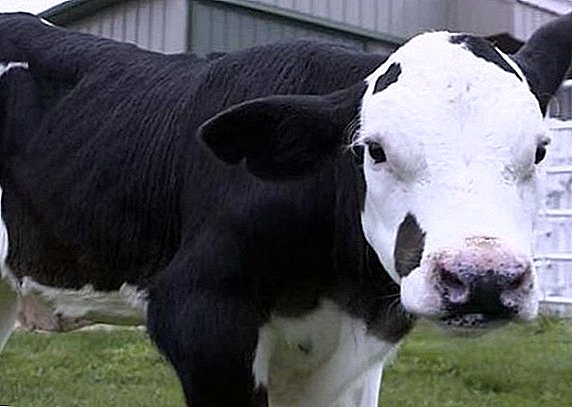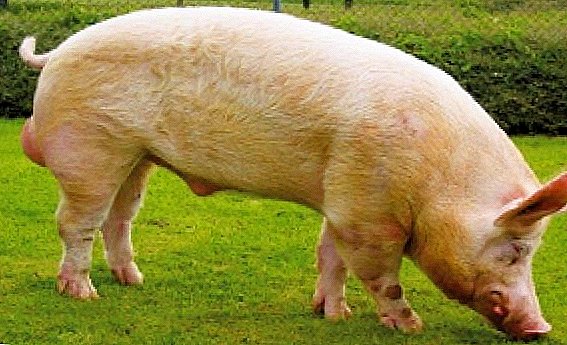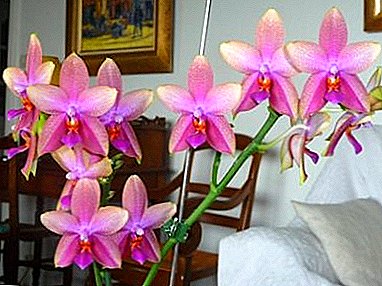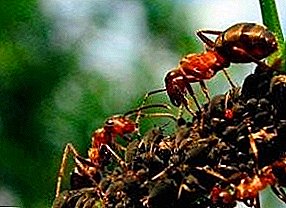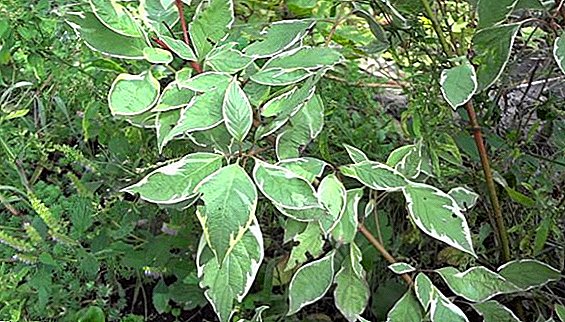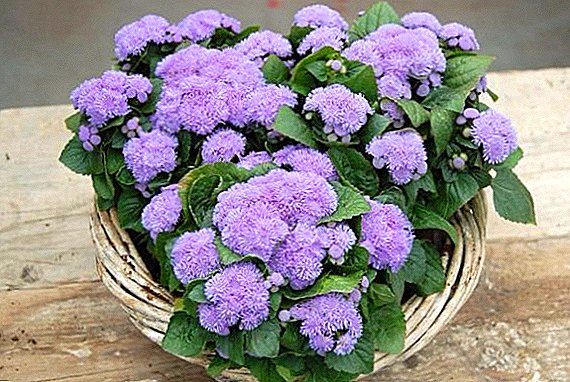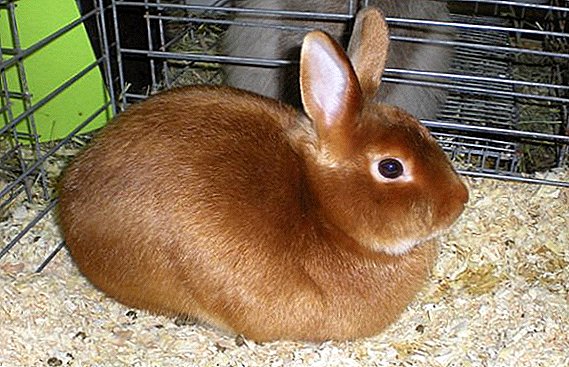 When breeding rabbits sometimes the choice of breed can be a problem. In order to know exactly what the selected view is right for you, you need to familiarize yourself with its characteristics.
When breeding rabbits sometimes the choice of breed can be a problem. In order to know exactly what the selected view is right for you, you need to familiarize yourself with its characteristics.
Among the various breeds, the satin rabbit, which is famous for its special fur, is popular.
Description and features of the breed
The satin rabbit differs from other species primarily in bright color and unusual fur.
Inference history
The history of the breed began in 1932 in one of the farms of the state of Indiana, USA, when an unusual fur was seen in the Gavan rabbit breed. To consolidate this feature, as well as to bring out different shades of such wool, the owner, Walter Huey, began to cross individuals with such a trait.
Read about the best representatives of fur and down rabbit breeds.
At the beginning of 1934 in the town of Pendleton, these rabbits were presented at a local exhibition, where they selected the best individuals in the breed. Their participation was not victorious, since the judges evaluated the animals according to standard characteristics, and the satin ones had an unusual appearance. However, sateen rabbits still noticed and became interested in them.  In 1946, 2 subspecies of satin rabbits were officially recognized for the first time. After that, experiments began, and in 1956, eight subspecies of satin animals were recognized. And in 2011 more than 12 subspecies with such fur were officially registered.
In 1946, 2 subspecies of satin rabbits were officially recognized for the first time. After that, experiments began, and in 1956, eight subspecies of satin animals were recognized. And in 2011 more than 12 subspecies with such fur were officially registered.
Appearance and parameters
Satin rabbits have the following characteristics:
- Weight: about 5 kg.
- Body length torso: large, has a conical elongated shape, length - medium.
- Lethal age: 4-5 months;
- Meat yield: pure meat is 60% of the total weight of the animal.
- Coat length and color: 3 cm, can be various shades, hairs thin and silky.
- Head: small size, round shape.
- Neck: small in size, thick.
- Paws: large, massive, especially the rear.
- Eyes: small, oval-shaped, arranged in parallel.
- Ears: omitted, but have an even form.
Did you know? The longest rabbit ears that are officially registered are 80 cm.
That is, we can say that this is a rather large animal with a good meat yield and high-quality wool. 
Color and fur characteristics
Satin rabbits have a special satin shiny fur. The reason for this is a change in DNA, namely the SA gene, which makes the hairs very thin, which ensures their softness, smoothness and shine. The peculiarity of the breed is that there are cavities in the hairs, and when light passes through them, the hairs literally begin to shine. The animals also have a thick undercoat that helps them tolerate cold weather well.
Did you know? Earlier pelts of sateen rabbits were often issued as mink because they are very difficult to distinguish.
The color of sateen animals is very diverse. Among the colors and shades can be identified as follows:
- the black;
- chocolate;
- red;
- spotted;
- blue;
- purple;
- white;
- chinchilla;
- Californian;
- copper;
- Siamese.
 Copper color is distinguished by a special arrangement of various colors: blue - in the undercoat, copper and orange - in the transition to the main wool, dark, rich copper - from above. There is also a black layer that is almost imperceptible. Neck, head and eyes are lighter, circles can be observed, a gradient tail.
Copper color is distinguished by a special arrangement of various colors: blue - in the undercoat, copper and orange - in the transition to the main wool, dark, rich copper - from above. There is also a black layer that is almost imperceptible. Neck, head and eyes are lighter, circles can be observed, a gradient tail.
Important! Under poor conditions of life and nutrition, rabbits can become aggressive towards as to the owner, and to other rabbits.
Siamese color is also distinguished by an unusual combination of colors: various gradations of brown and gray. For example, the darker are the legs, the sides, and the brighter are the ears, the head, the tail.
Character
It is believed that this breed is one of the most accommodating, friendly, calm.
In general, it is not a very active form. Sateen rabbits feel good as a pet and even have a positive attitude towards children. But still they require special attention and walks, when the temperature outside becomes above 20 ° C. 
Advantages and disadvantages
The advantages of this breed include:
- unique coat color and texture;
- calm character;
- large yield of clean meat;
- the little rabbits can feed the young not only of their own species;
- high birth rate;
- do not require special care;
- large size and weight.
The disadvantages include:
- a lot of space is needed for housing, since animals are large;
- not very disease resistant.
Find out what a rabbit can hurt.
That is, sateen rabbits with proper care are very good pets, because they have much more advantages than disadvantages. 
Breeding and care
The sateen rabbit needs a spacious cage with a house, because by nature these animals need a burrow. It is recommended to take a pet at a small age so that he does not have problems moving and getting used to a new place. It is recommended to wean a baby from the mother at the age of 2-3 months, since with an earlier separation the baby may have apathy and poor appetite.
Before letting the rabbit into the house, it is necessary to make the animal preventive against parasites, vaccinations against myxomatosis and viral hemorrhagic disease.
Rabbits are very susceptible to attacks of small parasites, so you should know how to get rid of ticks and fleas in an animal.
To conduct such a vaccination is necessary after 1.5 months every six months. The last 2 diseases are not treatable, so prophylactic vaccination is extremely necessary. If the rabbit is still sick with one of these diseases, it is simply isolated from the others and does not carry out treatment, that is, the pet will be fatal.
The last 2 diseases are not treatable, so prophylactic vaccination is extremely necessary. If the rabbit is still sick with one of these diseases, it is simply isolated from the others and does not carry out treatment, that is, the pet will be fatal.
The cage itself should be equipped with a feeding trough and a watering device, and also have a bed of hay or sawdust about 5 cm thick. It is recommended to change litter at least 3 times a week, or more often as it gets dirty.
We advise you to learn how to make a feeding trough and a drinking bowl for a rabbit with your own hands.
In the absence of a high-quality feed, especially if the cage is made of iron, animals can develop diseases of the paws, such as poddermatitis. If this happens, it is necessary to lubricate the wound with Vishnevsky ointment or treat with iodine.  It is also recommended to walk rabbits outside in warm weather, or to walk around the house without a cage. In the complete absence of walking and physical activity, the rabbit can become obese, to which these animals are prone.
It is also recommended to walk rabbits outside in warm weather, or to walk around the house without a cage. In the complete absence of walking and physical activity, the rabbit can become obese, to which these animals are prone.
When leaving also should not be allowed:
- drafts;
- direct sunlight;
- unsanitary conditions;
- air stagnation;
- very low temperatures.
Novice rabbit growers should know whether it is possible to give animals cabbage, corn, pumpkin, wormwood, cherry branches, grapes, peas.The optimum temperature is 19-20 ° C. Power make up:
- fresh hay;
- various herbs;
- bark of trees;
- twigs;
- dandelions;
- cereals in the form of millet, millet.
You can also use special feed. Most often from the feed used granulated feed. It is recommended to transfer small pets to such food gradually, adding it to their standard diet a little bit.  The conditions of detention in a special shed should be the same as in the house, but a special courtyard can be made for walking. For breeding satin rabbits, the female should be placed near the male. After the rabbit becomes pregnant, she begins to make a nest. Priplod is about 5 times a year, 5-7 rabbits. So, we can conclude that the satin rabbit is a rather large animal with a unique coat and interesting color, as well as a sweet temper. With proper care, you can get a high level of offspring and, accordingly, a large yield of meat and wool.
The conditions of detention in a special shed should be the same as in the house, but a special courtyard can be made for walking. For breeding satin rabbits, the female should be placed near the male. After the rabbit becomes pregnant, she begins to make a nest. Priplod is about 5 times a year, 5-7 rabbits. So, we can conclude that the satin rabbit is a rather large animal with a unique coat and interesting color, as well as a sweet temper. With proper care, you can get a high level of offspring and, accordingly, a large yield of meat and wool.


